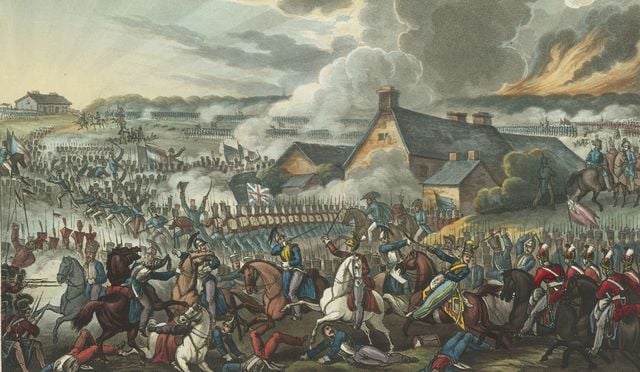Fighting for the King’s shilling - the Irish at war under an Irish Duke of Wellington fought and died in battle against Napoleon.
For almost a millennium the Irish have contributed men and military expertise to the English and British Crown from the Hobelar light cavalry in the 1200s to the First World War and beyond.
The 18th of June marks over two hundred years since probably the most significant battle in the history of the Western world took place - The Battle of Waterloo.
There were Irish on both sides with the vast majority fighting for the British, at least 40 percent, which doesn’t include first and second-generation Irish fighting in French, German states and British regiments.
Unlike Britain which was undergoing an industrial revolution, Ireland was suffering from massive unemployment which was disproportionately higher amongst the Catholic majority who were victims of discrimination legalized by the harsh anti-Catholic penal laws. There were three Irish predominantly, Gaelic speaking and predominantly Catholic Regiments on the field that day: The 27th Foot Inniskilling Fusiliers. The 6th Inniskilling Dragoons and the 18th Kings Irish Hussars.
Napoleon Bonaparte, Emperor and scourge of Europe had massed an army of 73,000 battle-hardened troops and was now facing an Anglo-allied army of 68,000 led by the Irish-born Aristocrat, Arthur Richard Wellesley 1st Duke of Wellington. A Prussian army of 50,000 led by the old war horse Gebhard Leberecht von Blucher would eventually join the battle and decisively turn the tide for Wellington.
Napoleon's troops were largely experienced veterans, who were fiercely loyal to their Emperor whilst Wellington led a rag-tag assembly of Dutch, German states and 25,000 British regulars. Despite Wellington infamously declaring that his men were the scum of the earth. He would graciously concede in 1829, when the Catholic Emancipation Bill was put before the House of Lords, that ‘It was mainly due to the Irish Catholic that we (The British) owe our pre-eminence in our military career’. Wellington’s support for Catholic emancipation would even lead to his participation in a duel with the rabidly anti-Catholic Earl of Winchelsea!
Of The 25,000 “ British” troops on the field that day only 7,000 had any real battle experience, most of those were infantry, the majority being Irish.
“THE REGIMENT THAT SAVED THE CENTRE OF MY LINE”
- Duke of Wellington
The 27th-foot Inniskilling Fusiliers had occupied a key strategic position on the forward slope of a ridge in the center of Wellington’s line. For two seemingly eternal hours the 27th consisting of 747 infantry, had endured continual sniping from French sharpshooters and despite the constant pounding of artillery, the line still held. As the battle progressed squares were formed to repulse the onslaught of the French cavalry. Comrades, brothers, and cousins fell. But with extraordinary courage and amazing resolve, the 27th still held. By this most remarkable display of self-sacrifice, the 27th had given Wellington a most precious gift. The 27th had given Wellington an essential ingredient without which his plan would have certainly failed….Time.
“GIVE ME NIGHT OR GIVE ME BLUCHER”
- Duke of Wellington
Blucher’s army of 50,000 well-drilled, seasoned cavalry had been playing a deadly game of cat and mouse leading Marshal Grouchy’s 33,000 men away from Napoleon’s main force in an orderly planned retreat, all the time staying parallel with Wellington’s army. Blucher was now in the woods and in sight of the battle and following his earlier defeat at the battle of Ligny was seeking bloody revenge! Now faced with overwhelming numerical superiority, victory for Wellington was assured.

Love Irish history? Share your favorite stories with other history buffs in the IrishCentral History Facebook group.
The 27th had held, blocking the road to Brussels and a likely French victory. The Inniskillings had been decimated, more than 50% had been killed or wounded. Only two other Regiments would suffer such appalling casualties and they were both Scottish. Napoleon famously remarked “ That regiment with the castles on their caps composed of the most obstinate mules I ever saw; they don’t know when they are beaten”
On the 23rd of November 1918, Irish soldiers would again take to the field at Waterloo. After more than four years of unimaginable horror in the trenches of the Western Front. The 2nd Leinsters would be the first “British” infantry Regiment to march across the battlefield of Waterloo since 1815!
Leading the Regiment were the Pipers and Peter Farrell, my Grandfather of Newstone, Drumconrath, County Meath, was I’m proud to say one of them!
This article was submitted to the IrishCentral contributors network by a member of the global Irish community. To become an IrishCentral contributor click here.




Comments